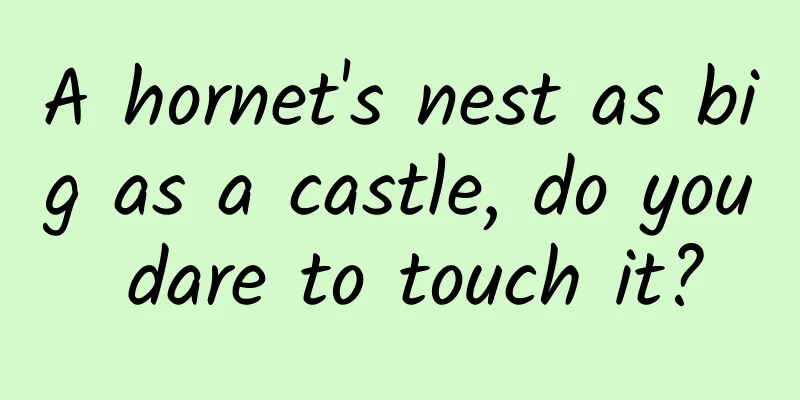A hornet's nest as big as a castle, do you dare to touch it?

|
“Poking a hornet’s nest” is a common childhood memory for many people. Although not many people have actually poked a hornet’s nest, most children will be warned by adults when they see a hornet’s nest: “Don’t poke! You’re risking your life!” At least other animals know not to get close to a hornet's nest. When I was a child, I never thought of poking a hornet's nest, but I did try to drive small insects such as grasshoppers and mantises to the hornet's nest, hoping to see a good show; however, when they got close to a certain distance, no matter how hard I tried to drive them away with small branches, they would not move forward. If I threw them directly at the hornet's nest, they would immediately retract their legs and fall down. This allowed my cruel childish heart to initially appreciate the magic of nature. Does it bring back memories? | Pixabay Wasp nest made of paper There are three words that we often use but are quite confusing: "hornet", "wasp" and "wasp". Hornets are actually members of the subfamily Pomacinae under the family Vespidae, while wasps are more narrowly defined as members of the subfamily Vespidae, which in a broad sense can include several families including the family Vespidae. There are also some other groups under the family Vespidae, such as the solitary wasps (guǒ) and wasps (luǒ), whose nests are not typical wasp nests. The scorpionfish make cute wine-flask-shaped nurseries out of mud | TimotheusB / Wikimedia Commons As for "wasp", it is even more difficult to say; the English word for wasp is wasp, which basically includes all Hymenoptera with stings except bees and ants, and most of them are small parasitic wasps that are not yellow. However, when we talk about wasps in our daily lives, we usually refer to large bees with eye-catching yellow colors such as hornets and wasps. Although they both look like hexagonal rooms, wasp nests are actually very different from honeycombs. Bees use their own unique material, beeswax, to build their nests, while wasps and hornets use plant fibers; it can be said that their nests are actually made of paper, so the English common name of the subfamily Polistinae is paper wasp. Since wasps can make paper themselves, of course they can also use ready-made paper. If they are given colored paper as a raw material, wasps can make a rainbow Mary Sue wasp nest | Jenny Jandt / youtube In addition, bees store pollen and nectar in their hives, but wasps and hornets do not. They are carnivorous. Although they also like to eat sweet food, they do not bring it back to the nest to store it. The Great Architecture of the Wasp Bees often build new nests by swarming, with the new queen leading a group of worker bees to "run away from home"; due to the large population, a decent hive can be built quickly. However, the new queen of wasps and hornets starts from scratch and can only rely on the strength of one bee at the beginning, starting with a mini hive with only a few cells. A wasp nest that has just begun to be built looks like a cute little lotus pod; at this stage, a wasp nest is not dangerous, after all, there is only one fighting member, the queen bee, and she has to leave the hive frequently to hunt and feed the first batch of larvae. After the first batch of larvae grow up and become worker bees, the queen bee can be considered to have initially completed her business and can hand over the work to her daughters. An expanding hornet's nest | Pixabay As more and more worker bees are added, the colony continues to grow, and the hive will also become larger. From the small lotus pod at the beginning, it begins to expand around and becomes a flat big shower head; when one layer is not enough, the hive will continue to build the second and third layers downwards, and each layer is connected to each other in the middle, just like a gorgeous chandelier. Finally, the outside of this "chandelier" will be wrapped with a thin "paper", leaving only a few exits, and it looks like a huge ball from a distance. Under the right conditions, a hornet's nest can be very large; for example, a giant hive that required an excavator to move was removed in Guizhou some time ago. The largest hornet's nest listed in the Guinness World Records was found in New Zealand, 3.7 meters long and 1.75 meters in diameter - compared to the Guizhou hornet's nest in the video, it doesn't seem to be much larger. A giant hornet's nest found in Guizhou | Weibo However, the hornet's nest in this record is a complete hive built on a tree, probably a nest of the German yellow wasp Vespula germanica, which eventually fell down due to being too heavy. As for the hive in Guizhou, although it is not clear who the owner is, it can be seen from the video that the hive is embedded in the house, and there are even steel bars embedded in the dismantled hive; occupying such a favorable location, the hive has lost its original clear structure on the one hand, and on the other hand, it has become more solid and can be expanded at will. Many of the super-large hives that have been dismantled are often located on houses. A hornet’s nest has arrived. What should I do? A hornet's nest that cannot read the air and is not picky about where it is is naturally a threat to nearby residents. So, should you poke a hornet's nest? First of all, you should never poke a hornet's nest; you need to have the right technique to safely remove a hornet's nest. Professionals usually wear special bee-proof clothing and use fumigation and other methods to drive away the swarm, or kill the swarm with drugs first; another method is to carefully cover the swarm at night when the swarm is resting and remove it - you must not touch the swarm when covering it, as they are quite sensitive to vibrations even at night. Wasps make their home in helmets | Pixabay In temperate regions, no matter how spectacular a hornet's nest is, the bees inside will die in winter, leaving behind an abandoned empty shell. At this time, we can safely remove the honeycomb and get a honeycomb ornament that is both ornamental and educational. If you cut the honeycomb vertically, you can also observe the delicate honeycomb structure inside and marvel at the magic of nature. Whether it is a wasp or a hornet, they will not attack people casually; they will only fight back when they or their hive are threatened. When a hornet's nest appears in an area where people frequently move around, you can ask firefighters to remove it as soon as possible; because even if no one pokes the hornet's nest, if people accidentally get too close or touch the nest, they will be attacked by the hornets. Some types of hornets will build their nests underground, and if they are stepped on, they will alarm the entire swarm of hornets. This is like a biological landmine that is hard to guard against; I have been attacked by it. This is a two-year-old nest of Vespula squamosa from under a roof in Alabama, USA | Hornetboy1970 / Wikimedia Commons The venom of wasps and hornets is not toxic in itself, and the severity of the sting depends on the degree of the allergic reaction. For people who are not very sensitive to bee venom, bee stings only mean some swellings that will subside on their own after a while; for people with certain allergic reactions, the swelling will last for a while. At this time, you should pay attention to the cleanliness of the wound to avoid infection, apply antibiotic ointment externally, and take some allergy medicine to relieve symptoms. People who are highly allergic to bee stings may have anaphylactic shock or even death. In this case, you must go to the doctor immediately for rescue. If you know that you are highly allergic to bee stings or other common allergens, carrying an epinephrine pen with you can save your life at a critical moment. German wasp nests are usually built close to the ground | Hornetboy1970 / Wikimedia Commons But when wasps’ nests are located in their natural environment at a safe distance from humans, there is absolutely no need to disturb them. Wasps and hornets are the largest eusocial animals we see on a daily basis (naked mole rats, which are larger than them, can only be seen in a few zoos). They are not only very important predators in the ecosystem, but also amazing and beautiful animals in their own right; as long as we don’t disturb the nest, we can safely observe their interesting behaviors and ingenious architectural talents up close. Author:ChenZ Edit: Red Queen This article comes from the Species Calendar, welcome to forward If you need to reprint, please contact [email protected] |
<<: What are we talking about when we talk about urban biodiversity?
>>: How are cat poop coffee and decaffeinated coffee made? Four reasons for coffee
Recommend
Microsoft HoloLens ushers in the era of "brain intubation". Is The Matrix about to become a reality?
I believe that those who have watched "The M...
Are screen-sweeping ads reliable?
Today’s topic is “screen-sweeping ads”. I’m lazy ...
How to operate an event (Part 2)
How to operate an event (Part 1) To operate produ...
Android Permission Management Principles (including 6.0)
Preface Before MarshMallow, permissions were gran...
Who is Zeng Hou Yi of Suizhou?
This is a Names not recorded in history books 197...
How to make voice interaction more natural? Master these 6 key knowledge points first!
I recently read a few very good articles about ro...
The first dynasty in the northern frontier, Lai Liao!
Of course you know Song It is the main character ...
Alibaba-Meizu marriage: ambitions and lies in the new ecological era
How far are the capabilities of smartphones? Over...
Are you aware of the risks of exposure to nail lamps if you love doing manicures?
The Spring Festival is here, and many beauty-lovi...
Yin Chen's new course "2022 Algorithm Disassembly and Gameplay Analysis" Qianchuan Launches 100 Questions Practical Disassembly
Introduction to the video tutorial lecture of the...
Download the Nanfang professional naming program, Nanfang professional naming software mobile cracked version registration code
This program is applicable to Windows 10/Windows ...
The first place of "the dirtiest fruit", be careful if you take one bite! Many people like to eat it in summer
With the arrival of hot summer, street fruit cutt...
The past, present and future of fire extinguishers
Fire extinguisher is the most important tool for ...
Anhui Jinzhai Red Education Base
Anhui Jinzhai Red Education Base training consult...
The latest news on Changchun’s unblocking time in 2022: When will the lockdown be lifted and normalcy restored?
At present, the local epidemic situation in Jilin...









